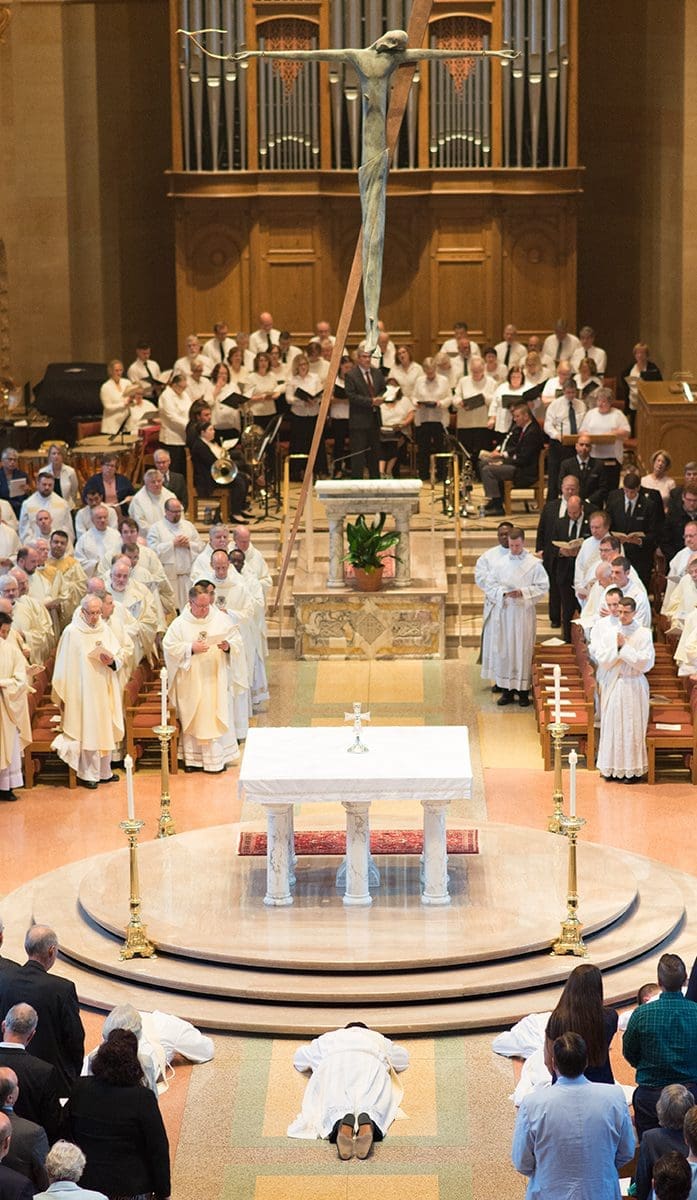
Five priests were ordained at the Cathedral of St. John the Evangelist on May 19. (Photo by Pete Fenelon)
“You are a priest forever, in the line of Melchizedek.”
The ordination of priests for the Archdiocese of Milwaukee on the morning of Saturday, May 19 was many things. It was a celebration, it was a graduation of sorts — most noticeably, it was a standing-room-only liturgy infused with a deep sense of joy and fulfillment, as relatives and friends of the five ordinandi filled the pews and lined the walls of the Cathedral of St. John the Evangelist.
But in many ways, it was also a lesson in spiritual genealogy.
In the Liturgy of the Word, the origins of the priesthood were traced throughout the Old and New Testaments, beginning with the third chapter of the Book of Numbers, where God distinguishes the tribe of Levi as “set apart,” dedicated to service in his temple.
It continued on with the singing of Psalm 110: “The Lord has sworn and will not waver: you are a priest forever in the line of Melchizedek.” Melchizedek was a priest-king who appears in the Book of Genesis; as his ancestry is unknown, his priesthood is presented as a contrast to that of the Levites, for whom liturgical service is a birthright.
In the second reading, St. Paul writes to the Hebrews that, “when he was made perfect,” Christ, who was not a Levite, “became the source of eternal salvation for all who obey him, declared by God high priest according to the order of Melchizedek.”
And finally, the Gospel — the story of the Last Supper, wherein, on the eve of his Passion and death, Christ ordains a new order of priests to act as his ministers. In doing so, he establishes a sacred lineage, one that is shared even today by priests who recreate, at each consecration, his sacrifice on the cross — a perfect sacrifice, one that the Levites of old could not accomplish.
On May 19, that priestly family gained five new members — Fr. William Arnold, Fr. Andrew Infanger, Fr. Aaron Laskiewicz, Fr. John LoCoco, for the Archdiocese of Milwaukee, and Fr. Vincent Nghiep Van Pham, ordained for the Congregation of the Sacred Heart of Vietnam.
In his homily, Archbishop Jerome Listecki echoed the Scriptural emphasis on the presbyterate, telling the ordinandi that “you will be joined to all the priests who have been ordained in the service of the Church, yet at the same time, your ordination will be unique in the personal gifts you bring to the people of God.”
“I was not surprised by your selection for the readings of this liturgy,” he said. “Knowing you in the years of your preparation for the priesthood, I would have characterized service as a central theme of your commitment. But it is a service in the name of the Lord which heralds your ordination.”
“Your vocation as priests, received as a gift to the Church, will assist the communities you serve in attaining holiness,” he continued. “The sacraments you administer will be the source of grace. Think of it — God will be using you as an instrument, affirming and drawing his children towards the ultimate destiny of eternal life. You will be a conduit for God’s activity among his people. The scriptures you proclaim and the doctrine of the Church you will teach will guide the faithful in truth.”
The archbishop had earlier made reference to another high-profile occasion of the day, one taking place thousands of miles away — the marriage of Prince Harry and Meghan Markle at Windsor Castle.Admitting that in the wee hours of that morning he had “taken a peek” at the news coverage of the royal wedding, the archbishop said he noticed some similarities between the two events.
“The royal wedding … is about love,” he said. “My brothers and sisters, this (ordination) is a symbol of love — the commitment that my brothers are making to the person of Jesus Christ. And the symbol of love is found in the cross — a self-giving, a turning over,
an emptying.”
Following the homily was one of the essential rites of the sacrament of Holy Orders — the Laying on of Hands, when the bishop imposes his hands on the ordinandi and, through his prayer, confers upon them the gifts of the Holy Spirit that will be required by their ministry. Following the archbishop’s action, all priests present do likewise.
This was one of the most powerful parts of the ordination rite, said Fr. Arnold afterward — a rite that underscored his incorporation into this blessed, ancient brotherhood.
“I looked at the faces of all the priests and it was incredibly moving, because many of them have become friends to me over the years of seminary formation,” he said. “They’re all different ages and backgrounds, but they’re all priests. To see the faces of the priests who were just a year or two ahead of me in the seminary was really cool. I was becoming a priest with them in those moments.”
And they shall be priests forever, in the line of Melchizedek.
